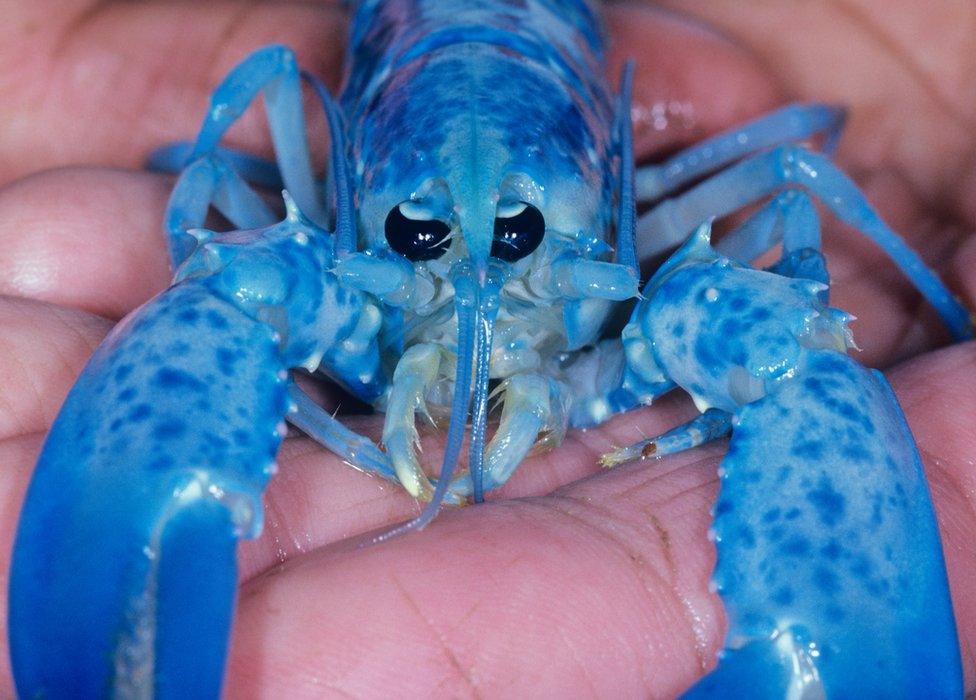How rare are bright blue lobsters?
- Published

Two Canadian fishermen have been celebrating catching bright blue lobsters over the last few days. But how rare are these striking-looking crustaceans, asks Justin Parkinson.
Lobsters caught off the Atlantic coast of North America aren't usually very bright. They tend to be a murky, greeny-brown... until they are boiled, when they turn the orangey-pink familiar to diners with high disposable incomes.
So two fishermen off the coast of Nova Scotia made the news when they caught not one, but two, external vivid blue lobsters in quick succession, 150km (93 miles) apart. Among the region's fishermen, it's traditionally considered to be a sign of good fortune.
The probability of the creature having this colouring is widely touted as being one in two million. The University of Maine Lobster Institute, external is among those to have quoted these odds in the past, though its executive director, Rob Bayer, admits they are merely a "guess".
"The chances of this happening nobody really knows," he says.
David Spiegelhalter, professor for the public understanding of risk at Cambridge University in the UK, is inclined to pour a bit of cold water on the story.
A rough analysis of overall catch tonnages suggests that about 200 million lobsters are caught in the North Atlantic every year, he says. That equates to 100 blue ones turning up in a year on average, if the one-in-two-million odds are correct.
"So for two to be caught three days apart, quite close to each other, does not seem at all surprising," says Spiegelhalter. "I would imagine it happens most years."
Bright blue lobsters are so-coloured because of a genetic abnormality that causes them to produce more of a certain protein than others.

A normal European lobster, and (right) a blue one caught in Scotland in 2011
They stand out from the rest of a catch, particularly in western parts of the North Atlantic.
"The American lobster is usually a sort of greeny-brown, so anything bright blue would look very odd to fishermen there," says Charlie Ellis, a researcher at the UK's National Lobster Hatchery, in Cornwall.
"But European lobsters tend to be a duller blue colour. The real sort of iridescent blue is still rare here, but the difference is that, to a European fisherman, it will seem less completely out of the ordinary than it would seem to a North American."
Ellis thinks the probability of a lobster being bright blue may be as low as one in a few hundred thousand. But another British expert, Andrew Parker of Oxford University's zoology department, disagrees - he backs the one-in-two-million estimate.
It's safe to say that other kinds of lobster are even rarer. Yellow lobsters account for about one in 30 million of total stocks, the Lobster Institute estimates.
But two fishermen in Dorset hit the ultimate lobster-probability jackpot in 2011 when they caught an albino, or "crystal", lobster - the odds of this are reckoned to be one in 100 million.
"Whatever the odds of catching different-coloured lobsters, there's no denying that bright blue ones are truly beautiful creatures," says Bayer. "They might not be the most unusual, but they are undoubtedly the best to look at."
One of the Canadian blue lobsters has already been returned to the sea. The other will be kept in a tank and released after the end of the lobster season in mid-July.
Follow Justin Parkinson on Twitter @justparkinson, external
Subscribe to the BBC News Magazine's email newsletter to get articles sent to your inbox.